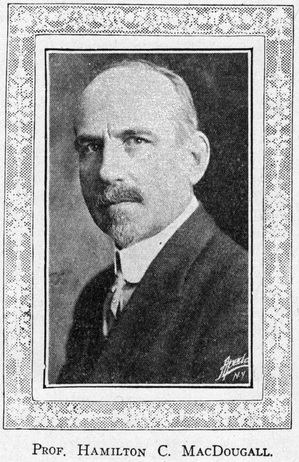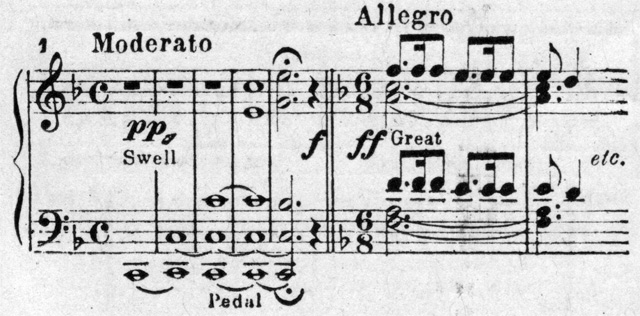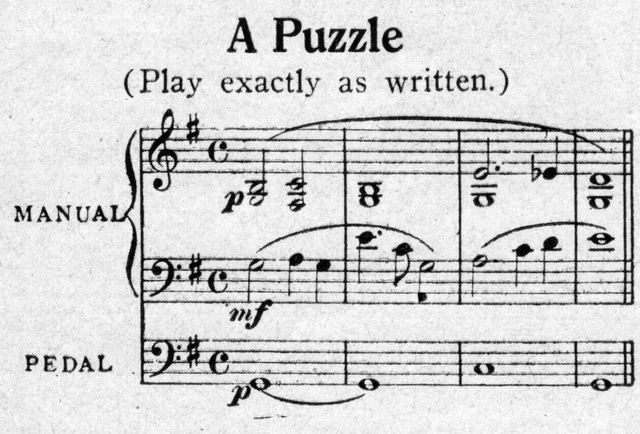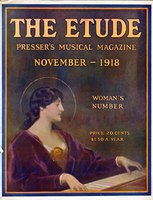Edited for November by HAMILTON C. MacDOUGALL
“The eloquent organ waits for the master to waken the spirit”—DOLE
The Organist As Church Musician
By Hamilton C. MacDougall, Professor of Music, Organist and Choirmaster of Wellesley College, Mus.D. (Brown University), F.G.O., A.R.C.O.
 In everything manner counts. You begin to like or dislike the violinist as soon as you get his full length on the stage. The attitude of a pianist at the keyboard either suggests power and gives us confidence or something less inspiring. You judge a musician somewhat by the elegance of his studio or by his bearing in social intercourse. In like manner, no matter how clever an organist may be in the actual performance of the music before him, he may make a good impression or a poor one by the way he handles the details of the service.
In everything manner counts. You begin to like or dislike the violinist as soon as you get his full length on the stage. The attitude of a pianist at the keyboard either suggests power and gives us confidence or something less inspiring. You judge a musician somewhat by the elegance of his studio or by his bearing in social intercourse. In like manner, no matter how clever an organist may be in the actual performance of the music before him, he may make a good impression or a poor one by the way he handles the details of the service.
In truth the organist in church has a threefold personality. He is a musician and therefore must play correctly; he is an officer of the church and must play religiously; he will fail in his duties if he be not a bit of a psychologist. Let him answer three questions. Do I conform to the high standards of my profession? Is the music I select and style of playing I affect in church secular? Do I consider the reactions from my performances?
Beginnings: the Prelude
If the time of beginning the Prelude is fixed by the organist and therefore unknown to the congregation, remember that the abrupt, somewhat unmodulated tone of the organ will startle the ears of the congregation. Do not begin the Prelude with a loud chord. Is there anything more boorish—musically speaking—than the rude interruption of one’s before-service meditations by an unexpected, noisy chord from the organ? If the day is a festal one, like Easter or Christmas, the Prelude may—ought to be—joyful and full; but even then it is well to introduce it by a brief bit of music, crescendo molto; for example, if the Prelude chosen be Wachs’ Hosannah! begin thus

Begin on the swell organ with the stopped or open diapason (box shut), adding stops in appropriate order (box opened gradually). When it is fitting to begin the Prelude fortissimo or even forte it will be readily sensed by the organist.
A different order of beginning is necessary when the church has a bell. The organist will, no doubt, have discovered the pitch of the bell and will take care to choose the key of the Prelude with that in mind. If the bell be pitched on “F” a Prelude in F or B flat or C will not be troublesome; but if the Prelude key be G or E or G flat, etc., a brief introductory modulation on soft stops will be
necessary. If the key of the Prelude and the pitch of the tolling bell are related, any Prelude will follow without æsthetic disturbance, since the congregation expect the organ to begin and are on the lookout—consciously or unconsciously—for it.
Whatever the intellectual or emotional keynote of the service as a whole may be, it is certain that it ought to be meditative at the start; it is also certain that it is in the power of the organist to help and to hinder. If the idea of meditation is the correct one it will be seen at once that Wachs’ Hosannah!, with its stirring rhythm would be highly unsuitable for any save a festal service whose motifs are life and buoyancy.
All music in church must be made to sound as if it belonged, not like something brought in from outside.
The Hymn-Tune
After the hymn is announced the congregation is expecting the tune to be played over and it is, therefore, quite possible to begin it with any combination, loud or soft, thought proper, without incurring the penalty of an aesthetic crime. Some organists begin the hymn- tune for congregational singing by striking the soprano tone a beat in advance of the first chord. The advantage of this is that it serves as a rallying point, gives the congregation time to get its breath and give the first chord its proper length. To begin the hymn-tune without the anticipatory tone cuts off a portion of the first chord of the tune. Personally I like the preliminary notice which the fashion gives, it corresponds to the slight introductory motion that a conductor makes before bringing down his baton on the first beat. Many excellent players object strenuously to this way of beginning on the ground that it is both amateurish and unnecessary. But to get an excellent start without using the anticipatory tone it is necessary to play the tune so that from the last note in each stanza of the hymn to the first note of the next stanza, the elapsed time shall be the same; in this way only can a congregation get to know when the next stanza is going to begin and thus get the full time of the first chord.
Organists who do not sing have their own peculiar faults; one of these is allowing too little time between the stanzas of the hymn. It is an excellent plan to follow carefully the various stanzas of the hymn in order to get the sense of the words and make appropriate registrations.
The Anthem
Here again, the congregation is expecting the music and the playing may begin at once on the prelude to the Anthem as written. If there be no written prelude
the organist will necessarily either improvise one or take four measures of the Anthem itself for the purpose; if the former, let the last chord of the prelude end on the dominant chord of the key; if the latter, be careful to take the exact tempo and style of the Anthem. The second method has thus an
advantage in giving the choir a valuable cue; sometimes, however, the bald repetition of the four measures of the Anthem suggests poverty of resource.
The Postlude
At this point it is true that the congregation is expecting the music; but since after the Benediction there ought to be a moment of quiet—perhaps five seconds in length—the organ ought again to begin piano, and not interrupt the presumably solemn impressions gained at this point by the organ’s stiff, hard, unmodulated tone. Begin rather on the softest stop, increasing quickly but smoothly to the combination selected for the beginning of the Postlude proper.
Endings: The Prelude
One must always bear in mind that the perfectly even, unmodulated tone of the organ is like nothing else in our musical experience. It attacks our ear, holds our attention with a sustaining power unequaled by voices or by any other instrument or combination of instruments, and when it ceases it stops as abruptly as it began. What psychologists call “reaction” must be taken into account in any discussion of the way to handle the organ in church. The positive, abrupt, aggressive beginnings and endings, quite proper
when one is playin ga (sic) recital, produce an undesired reaction when employed in church. This consideration justifies the diminuendo ending on the organ for nearly all final chords in the Prelude, Anthems and Hymn-tunes. There arc exceptions to this, of course, but on the whole it is a rule.
I am bound to admit that this rule is by no means universally approved by organists; some of the best men in the profession set their faces against anything of the kind. The arguments against it are based largely on the fact that in concert practice we play our music as it is written, adding nothing and taking away nothing; and that to tack on a diminuendo ending to the Finale of the Beethoven Fifth Symphony—to take an example—would be a crime against art and nature.
I am not so sure about that. If it be granted that Beethoven’s Finale be a proper Prelude to a church service I am quite convinced, for my part, that after its conclusion something to let the congregation down from its state of excitement would have to be done; what better could be imagined than a long, improvised diminuendo balancing the long and exciting coda with which Beethoven’s immortal work concludes. We all must, I think, concede the unsuitability of much fine music for church use; it is too sensuously stimulating, too rhythmical, too active in suggestion. But if we once concede this we have admitted my main plea, which is that in many respects the selection of music and the handling of the organ as a concert or recital instrument is not necessarily a model for the church service. The modifications I am suggesting may not be the ones that are most suitable, but modifications of ordinary concert procedures are necessary.
As a test case let us consider a piece like Allitsen’s The Lord Is My Light. The piece is jubilant, strong, virile, full of motion, life and energy. I remember hearing the accompaniment played by one of my friends, a most capable concert and church player. He ended it fortissimo, the final chords as clear as if they had been snapped off with a whip; a splendid bit of strong, aggressive playing. The chords actually bit chunks out of the silence that followed, and I, for one, felt as if I had been dropped from the steeple’s top to the sidewalk. As a performance it was splendid, but as church playing it jarred as something strangely out of keeping. Or, take Gounod’s Unfold, Ye Portals Everlasting from The Redemption. There are some fifteen or twenty measures following the magnificently effective chorus; the fortissimo is kept up to the very last bar, and an added or further climax is given in the last measure by a chord on the brass, fff. Was it not at some moment like this that the minister began his reading of the Scriptures with the verse, “And after the uproar had ceased”? Surely in both these cases there must be a coda, so that the reaction from the tremendous volume of sound shall not be painful.
The diminuendo on a single chord is managed as follows: let us suppose that the final chord is played on the full great with full swell coupled, swell box open; transfer the right hand, after reducing the great somewhat by using the pistons, to the swell manual, without making a break, following this by the transfer of the left hand to the swell. While this has been going on the great to pedal coupler has been taken off, and the swell reduced somewhat. The swell box may now be shut, and at the same time more stops taken off, until the swell is reduced to the softest stops; the final step is to drop off the notes of the chord from top to bottom allowing the pedal note a moment only, to hold on after the last manual tone. In all, this reduction ought to take from four to six minutes. The improvised coda will naturally take more time.
It can easily be carried to an extreme, this process of “tapering off”; I have heard the last pedal tone prolonged (especially if on a fat-scaled Bourdon) when I would have killed the organist on the spot had I access to the organ loft. Indulged in as I have tried to describe above, I believe the practice to be æsthetically sound.
Here, again, one needs to remind oneself that there are cases where the last organ chord, if played diminuendo, would cancel the whole effect of the Anthem or Voluntary; organists of taste will recognize these places readily on their occurrence.
The Hymn-Tune and the Anthem
What has been said about the Prelude applies equally to the Hymn-tune and Anthem. It is necessary to take into account the reaction to these on the part of the congregation. In Hymn-tunes the Amen is usually an example of the diminuendo ending, and its excellent effect is generally acknowledged. This, doubtless, explains the universal adoption of the Amen at the close of a hymn, even when it is clearly inappropriate. A jubilant hymn might well be ended with a fortissimo Amen, the tapering off by the organ following; where the choir are well drilled and quick to take a hint, the Amen can be taken in a high position so as to be more effective.
A Caution
In all that has been suggested in regard to the various modifications of concert practices recommended for church playing, the organist needs to be careful not to prolong the service or so to embellish it as to make himself a bore. I have known men who felt so sincerely their religious responsibility for the service that they overdid it and became nuisances; these cases are not common, it is true, but they do exist.
Smoothness
What is “smoothness”? Ever since I began to play the organ I have heard “smoothness” named as a desirable quality for every organist to have, indeed, an
indispensable quality. It by no means follows that a good recitalist is a smooth church player; conversely, many an excellent church player is an indifferent concert performer. For many years I thought that “smoothness” referred simply to legato playing, and it was not until I was musically thrown on my own resources that it occurred to me that by the word was meant a general ease and competency in the management of all details of the service. The music must flow on without hitches or breaks, one thing must be succeeded by another naturally, the registration must be planned and brought about as planned; there must be nothing spasmodic.
It takes both experience and long practice to arrive at the sort of playing known as “smooth.” Some of the things that contribute to it are (1) a good legato where legato is indicated; (2) perfect control of all beginnings and endings; (3) noiseless registration; (4) perfect rhythm in all preludes, hymn-tunes, anthems and accompaniments, with absolutely no loss of time for registration; (5) easy transitions from manual to manual; (6) avoidance of violent contrasts, as from soft to loud or loud to soft, unless specifically called for; (7) appropriateness of registration, particularly as regards solo and accompaniment; (8) perfectly distinct, but quiet phrasing ; and (9) where transitions are needed, covering up all joints and seams so that the music seems continuous, avoiding the awkward pauses characteristic of the incompetent.
Registration
There are, properly speaking, no rules for registration; yet it is possible to suggest certain principles that are helpful.
The old instructions bearing on the subject always dragged in a certain amount of elementary acoustics, valuable enough to be sure, but not very practical. After explaining that (1) the open diapason 8’ octave 4’ twelfth 2 & 2/3’, and fifteenth 2’, represented (3) the fundamental tone with its second, fourth and fifth overtones, and that the mixtures (of various ranks) added some of the higher overtones, the teacher had told very little. From this elementary acoustical knowledge sprang the absurd rules—absurd so far as real helpfulness goes—that “The octave must never be used without the open diapason.” ”The twelfth must never be used unless the open diapason and octave are drawn,” etc., etc.
Any person with brains can see that, when the stops named are used to build up tones after nature’s manner, the rules given are apropos; but there is no reason why the octave, or the twelfth either, may not be used as solo stop if it fit the music one is playing.
Here are a few helpful things to say about registration, (a) See that the accompaniment is softer than the melody, when two manuals are used, (b) Choose contrasted tone-colors for the melody and accompaniment. (c) If the melody is played on a reed or pungent string tone let the accompaniment be on a flute tone. (d) Do not accompany a flute-toned solo by a reed or pungent string; the latter cuts through the flute; as a demonstration of this play any simple hymn-tune through with left hand, using doppel flute, gross flute, melodia or a fat stopped diapason or gedackt, the right hand using clarinet, oboe, or viol d’orchestre; now change about and note how the reed stop cuts through the flute tone, but when the flute tone is underneath the reed or pungent string, no matter how much louder the flute may be than the reed or string, the flute will not “queer” the combination. (c) Accompany a flute solo by a neutral-toned stop like a dulciana or a soft diapason. (/) In making a crescendo add stops in the order of their softness, beginning with the softest, (g) In making a diminuendo push in the loudest stops first. (h) If the pedals are used they should be coupled to the accompaniment—if coupled at all—and not to the solo combination. (i) Changes in registration ought to be made during the rests, or at the beginning or end of phrases. (/) The rhythm must never be lost the merest fraction through shifting stops,; if the desired change cannot be made, dispense with any change of registration at the point. (k) The crescendo pedal is not designed for use in small effects: if you must use it, do so only for the biggest climatic effects or when you need a sudden burst of .fortissimo.
The fundamental principle underlying all registration is this: Do not take the congregation into your confidence ! When you make a pause in your playing the congregation knows that you are hunting around for a stop: you are taking the congregation into your confidence. When you change stops in the middle of a phrase instead of at the phrasing point the congregation is very well aware of the change: you take the congregation info yiour confidence.
Registration is a matter of personality or temperament largely ; therefore do not hesitate to experiment with the stops of your organ, in private. It may be a small organ, but you can be assured that there is more in it than you have yet discovered. Your friend from across the way will play a while on your organ and you will hear sounds from it of whiclr you
Do Organists Practice?
When will organists realize that it is their duty, which they owe to their church and themselves, to practice not one hour a week, but at least one hour a day? I am not advocating an impossible ideal, for I am very busy with teaching, daily choral services and practices, but yet find time to spend on an average about one hour a day at the organ, and far more frequently at the piano. (Oh! that I could give more.)
Again, I always make it a point of selecting my Sunday voluntaries on the Monday before; consequently, during the week am able to work up some difficult pieces for services and recitals, which I give frequently. The fact is that organists (and teachers) make rules for their pupils’ practice but fail to do so for themselves; and in conclusion let me state that good, old maxim, “where there’s a will there’s a way.”
The way will not be very difficult to find if looked for with the determination to practice; then only can we expect people to listen to and enjoy our preludes and postludes. In this way we get credit for ourselves and for the church with which we are connected.— (F. R. C. O.)
never dreamed it capable. (1) Try every stop in the organ singly, in the top, middle and bottom of its range. (2) Try the four-foot stop an octave lower than the normal pitch. (3) Try these again, adding a soft dulciana 8’. (4) Try the sixteen-foot stops alone an octave higher than the normal pitch. (5) Try these again adding a soft 8’ stop. (6) Try every stop singly as a solo stop, not only at the normal pitch, but at the octave higher and the octave lower. (7) Be sure that in trying every possible combination that you do not fail to try those combinations that you are morally (though not aurally) sure will not be worth the trouble. By “try” or “trying” I mean playing for a few measures both in chords and as a solo. You will discover many unusual and good combinations. Make a mental note of the effective ones and remember in what sort of passage they sounded well. Nothing is learned in registration without experiment.
Fight against “rubber stamp” registrations ; leave your favorite combinations alone for a week and your thumb pistons alone for a month, and note the improvement in your coloring. We all fall into amazingly lazy habits: we love the ruts!
In Conclusion
To become a good church organist is no small achievement, for it sometimes seems as if the church organist begins where the recitalist leaves off. The former needs all the execution of the latter, but the latter has never been compelled as a recitalist to consider “beginnings” or “endings” or “smoothness.” Reactions are outside his sphere of activity except as they arise in moving from, piece to piece in his program or as they may be a factor in the general impression made by his personality on his audience. Many things the concert player must learn when he sits on the bench Sundays. To be a good church player is to be an artist in a field little known to the ordinary musician and often little appreciated.
Transposition of Hymn-Tunes
In the ordinary congregation there are so few people who can sing higher than E flat, or at the most, F, that the organist ought to consider this fact when he plays the hymn-tune. I always play Jerusalem the Golden (Ewing) a semitone lower than written; even then it is high. Le Jeune’s lively tune to the same words is quite as effective in congregational use if in G, instead of A flat. Henry Hiles’ fine tune, St. Leonard, is entirely too high in G; in F it goes well. Diademata, Elvey’s tune to Crown Him With Many Crowns is a trifle better a semitone lower, since the general range is high, though the top note is only E. Nicaea (Holy, Holy, Lord God Almighty) by Dykes, Laudes Domini (When Morning Gilds the Skies) by Barnby, Ellers (Saviour, Again to Thy Dear Name We Raise) by Hopkins, and Eventide (Abide With Me) by Monk, are excellent examples of successful hymn- tunes of moderate compass.
Sometimes, though not often, tunes need to be raised in pitch. I always play Melita (Eternal Father, Strong to Save) by Dykes, a semi-tone higher, for the last four measures seem to need something of the kind. Twilight (Now the Day Is Over) by Barnby, has an exceedingly low soprano, which disports itself exactly in the weakest part of a woman’s voice; this was manifestly done for the sake of the tenor part, which is so high that it is impossible to transpose the tune upward even a semi-tone.— (H: C. M.)




